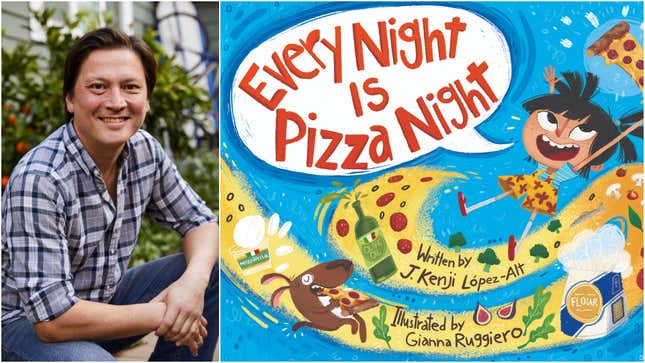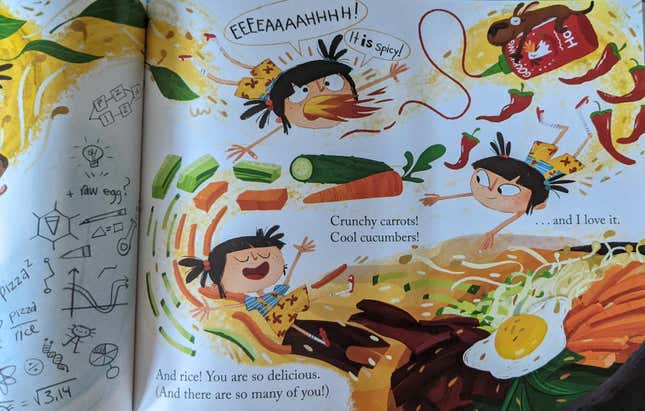
J. Kenji López-Alt is tireless in his mission to get us all enjoying food as much as possible. His work as Chief Culinary Consultant at Serious Eats, his 960-page opus The Food Lab, and his GoPro-assisted cooking videos on Instagram are all the perfect blend of ambitious and approachable, instilling his audience with a better understanding of, and confidence around, foods that might be unfamiliar to them.
Now López-Alt is bringing that same joy to a whole new generation of home cooks with Every Night Is Pizza Night, a children’s book in which the main character, Pipo, learns that her favorite food in the whole world (pizza!) might not be the only thing worth cooking. Pipo visits her neighbors’ homes looking for a meal that can rival pizza, getting a taste of bibimbap, tagine, red beans and rice, dumplings... and with broadened horizons comes a more complicated notion of which food is “the best.” We spoke with López-Alt about how he approached his first-ever children’s book and how it just might help parents of picky eaters.
The Takeout: What inspired you to write a children’s book?
J. Kenji López-Alt: When my daughter was born, I shifted to being a full-time stay-at-home dad, so I put all my projects on hold. But then, about six months in, I was like, You know, I’m actually finding myself with a bit of extra time here. Infants sleep a lot, and I couldn’t keep a regular schedule; I didn’t know what to do with the random chunks of downtime, so I thought writing a book for my daughter seemed like a good idea.
I wrote the book essentially just for my daughter, but luckily I had a relationship with my publisher and they were just starting a children’s book division, so we thought we’d make it into a real book. The family in the book is pretty clearly me and my wife and my daughter, although it’s not fully realistic because she was six months old at the time I started writing it. It was for my daughter, and all the messaging was directly to her.
TO: Is she a huge pizza fan? It’s clear that she’s not a picky eater.
JKLA: Pizza was the first solid food she ate, and she still loves pizza. We don’t do pizza literally every week, but we make it at least two to three times a month. That can vary: English muffin pizza, real New York-style pizza, Detroit style, Neapolitan—we make it all. She loves cooking and she’s been cooking with me basically since I took her home from the hospital; she’s been in the kitchen every time I cook. Early on she’d be on a cushion on the counter, just kicking at the food. I’d hold it up to her nose so that she could smell it and see what’s going on. But now she likes to help, and making pizza is something she requests pretty frequently.
TO: The book features beautiful illustrations by Gianna Ruggiero. Pipo rides a cascading “wave” of ingredients and flavors as she tastes foods that are new to her. Were you active in the process of determining what those illustrations would look like?
JKLA: Gianna had a huge amount of autonomy, and I consider her an equal co-author of the book because the illustrations do as much of the storytelling as the words do. When I started writing the book, even before I had a contract, I went on Twitter and I basically crowdsourced an illustrator. I asked, “Does anyone have an illustrator in mind that works on kids’ books who would be interested in working on a project with me?” And it was pure coincidence that about five hours earlier on that exact same day, Gianna had put a tweet out saying, “Hey, I just lost my job, does anyone know of any work that an illustrator can find right now?” From Gianna’s portfolio, it was clear she was the right choice from the start.

I’m not used to collaborating, really. I’m used to working alone on my cookbooks. I do all the writing, all the recipe testing, and all the photos; I work from home and I work alone, so my initial thought was that I’d write the story and then write down, in detail, what’s going to be on every page so that it comes out exactly as what I pictured in my head. But after talking to some other children’s book authors, it was universally recommended that I don’t do that—that I should do the words and let the illustrator do the work of illustrating. You’re the writer, that’s your specialty, you’re good at that. But the reason you’re partnering with an illustrator is because they’re an expert too.
I gave Gianna character descriptions of everyone in the book, and then I gave her blank pages with words on them—she filled it all out from there. Next was a collaborative back-and-forth: The idea for the spreads where Pipo is flying through all the food just came up in conversation. We said, wouldn’t it be cool if when she opens up the tagine there was a big cloud of smoke, and then that cloud of smoke had pictures of Morocco? And when she’s smelling the bibimbap there’s pictures of Eugene’s grandmother as a child in Korea? That was the initial idea, that the food would transport her to the place where it was from.
But then we realized, well, actually, this girl is four years old—it’s not like she’s going to know much about Korea or what Eugene’s grandmother looks like when she was young. It should all be told from her perspective, and it should really be framed from the perspective of a child experiencing these foods for the first time. So rather than the specific places and the traditions of the food, we shifted it to being more about the actual ingredients and the flavors she’s experiencing for the first time.
TO: It makes the act of trying new food seem so exciting.
JKLA: Yes! The [pictures] all look like she’s flying, or riding a water slide. It’s just so fun.
TO: There tends to be a misconception with writing children’s books that, because there are fewer words than a novel, anyone could do it. But that’s obviously not true. What were some of the unforeseen challenges for you in writing this?
JKLA: As with any writing, I think the most difficult thing was finding the voice. It’s relatively easy to say, “All right, the theme of the book is going to be this. I want this kind of messaging in it.” And even the basic plot involves the same kind of tinkering that I would do with any writing: Is there a beginning, middle, and end? Does it tie together? That stuff is mechanical. The real difficulty is finding the voice—because children aren’t dumb. Children can follow characters and they understand characterization, so it has to be engaging. I rewrote this book probably 15 times from different perspectives: I wrote it in third person, I wrote it from Pipo’s point of view. Writing for adults, and especially writing for cookbooks, I know what my distinct voice is because I’ve been doing this for so long. But it was like starting that process all over again to find my voice for children. It’s just practice. After my daughter’s bedtime I would take my laptop, go to my restaurant, and sit there for three hours every night. That’s how I ended up finding a children’s book writing voice.
Also, fewer words doesn’t mean that there’s less story, or less going on. The first draft of the story I wrote was 10,000 words long! Then I had to cut that down by 90%. A good children’s story has all the same elements of any good short story, but you have to accomplish it in far fewer words, which in many ways I find more difficult. Each of those words has to be efficient. And a children’s story can’t just be for kids; ultimately it’s the parents who are making the decision to buy it and recommend it to other people—and they’re the ones who are going to be reading it over and over and over again. So it has to not be annoying.
TO: Do you think that parents might read this book to kids in an effort to get them to try more adventurous foods?
JKLA: I think so! Some parents have told me that their kids have been asking for the foods in the book that they had never heard of before. The goal is partially to get kids to become more adventurous eaters, but also, food is a gateway to learning about other people and other cultures, because food is such an inherent part of people’s everyday lives. So it’s mainly about getting kids interested in learning about other people and other ideas. It’s a message that seems especially important right now, given everything that’s going on with immigration and our interactions with people around the world. Learning what makes people different from [us] or the same as [us], and accepting the differences.
TO: Do you plan to write more children’s books?
JKLA: My next book is going to be a cookbook, and that’s hopefully coming out next year. After that, Gianna and I have a few more children’s book ideas. We’re considering a series where the side characters from Every Night Is Pizza Night are the main characters of their own food-based stories. I definitely plan on writing at least a couple more children’s books, because I enjoyed the process so much.